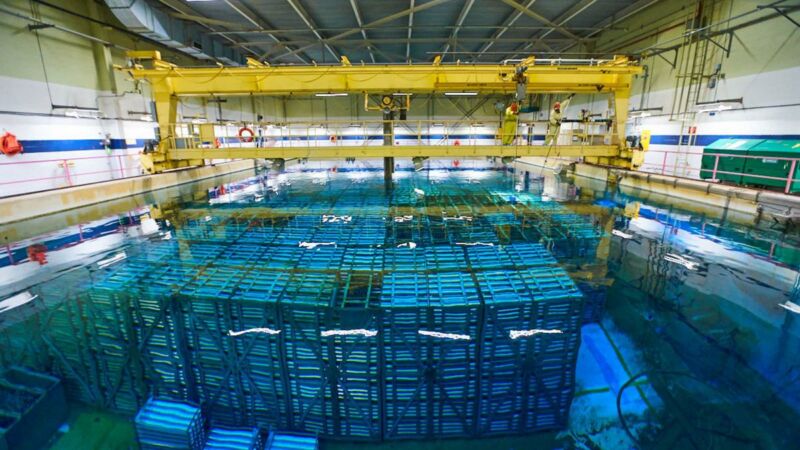
A number of countries, including the United States, has been planning for long-term storage of nuclear wastes. While many of these nations plan to keep the waste isolated from water, that's not something that can be guaranteed over the extremely long lifespans of the waste. If water reaches the radioactive isotopes, there's the chance that the isotopes could contaminate the groundwater in the area and spread well beyond the site of the storage repository.
To prevent that, plans are to have multiple layers of defense. The waste itself will be incorporated into a chemically inert, insoluble glass. And the glass itself will be placed in a stainless steel flask that will keep it from mixing with the surroundings.
Each of those materials seems to work well in tests. But now, a large team of researchers has found that, in combination, the materials aren't as robust as we'd like them to be. The problems only occur if water somehow gets into the container, but if it does, the interface between the glass and stainless steel actually accelerates chemical reactions that degrade both.
At the interface
The work focuses on what could happen if long-term exposure of the stainless steel flask to water causes sufficient decay to allow water to reach the interior. While some repositories are designed to keep the storage containers dry, it's not clear how successful that will be, since we don't really have the understanding of how changes in things like rainfall can affect groundwater flows on the sorts of time scales the waste has to be protected.
As a result, the planning has included designing materials that should be able to remain stable even if they're exposed to water. And, so far, testing of the stainless steel containers and the waste-containing glass have indicated that it can hold up to extended exposure to water. But the researchers here decided to test what happens when the two materials are brought in to contact with each other, as they would be during long-term storage.
In this case, water getting inside of the stainless steel container would percolate into the narrow space between the glass and the steel. And here, there's the possibility of what's apparently termed "crevice corrosion." In the narrow interface between the two materials, the chemistry can be very different than in a bulk solution. Local concentrations of dissolved material can be much higher, material that dissolves on one surface can immediately react with the other, and the chemistry can create feedback loops, greatly increasing the rate of otherwise rare reactions.
In the case of the crevice between the stainless steel and the glass, a lot happens when some of the metals present dissolve. They can drop the local pH, which will then increase the rate at which the stainless steel corrodes. Meanwhile, some of the dissolved metal ions will include some of the radioactive material. To balance the chemistry, the environment outside the crevice will become more basic, which could trigger additional chemical reactions.
Real-world data
That's what can happen. What actually does? To find out, the researchers used a standard (non-radioactive) glass material and stainless steel. These were pressed up against each other, and a solution of sodium chloride was added. The mixture was kept at 90°C for 30 days. The water had dissolved oxygen in it, which would be relevant to the conditions that might take place at the Yucca Mountain repository in the United States; other nations are planning repositories that would have anoxic conditions. At the end of 30 days, the team did some spectroscopic imaging to figure out where various materials ended up.
After 30 days, some of the glass was completely depleted of the metals it normally contains, leaving nothing but silicon behind. That's the typical result of acidic leaching on the glass. Instead, there was a significant amount of iron built up in the area, indicating that the stainless steel was also degrading. In fact, the researchers suggest that the chromium dissolving from the stainless steel enhances the general reactiveness of the environment.
The stainless steel surface itself was covered with a film that was primarily composed of iron and silicon, but also contained aluminum, sodium, and other metals. This implies that at least some of the dissolved material was re-deposited, near where they dissolved. To an extent, the film should reduce the corrosion of the stainless steel over time, but detecting that might require a longer-term experiment to detect.
None of this, obviously, is good news. As the authors state, "this could lead to an enhanced release of radionuclides from this ceramic waste form." Which, obviously, isn't what you'd want from a long-term nuclear waste storage.
This is only a risk if the waste containers are in contact with water long enough to lose some of their integrity. But that's valuable information, given that the risk evaluation involved with choosing waste repositories includes considerations of groundwater exposure. And it very strongly indicates that we have to do more testing of the entire waste-containment system, in addition to testing its individual parts.
Nature Materials, 2019. DOI: 10.1038/s41563-019-0579-x (About DOIs).
Bagikan Berita Ini














0 Response to "Planned nuclear storage material could decay faster than expected - Ars Technica"
Post a Comment